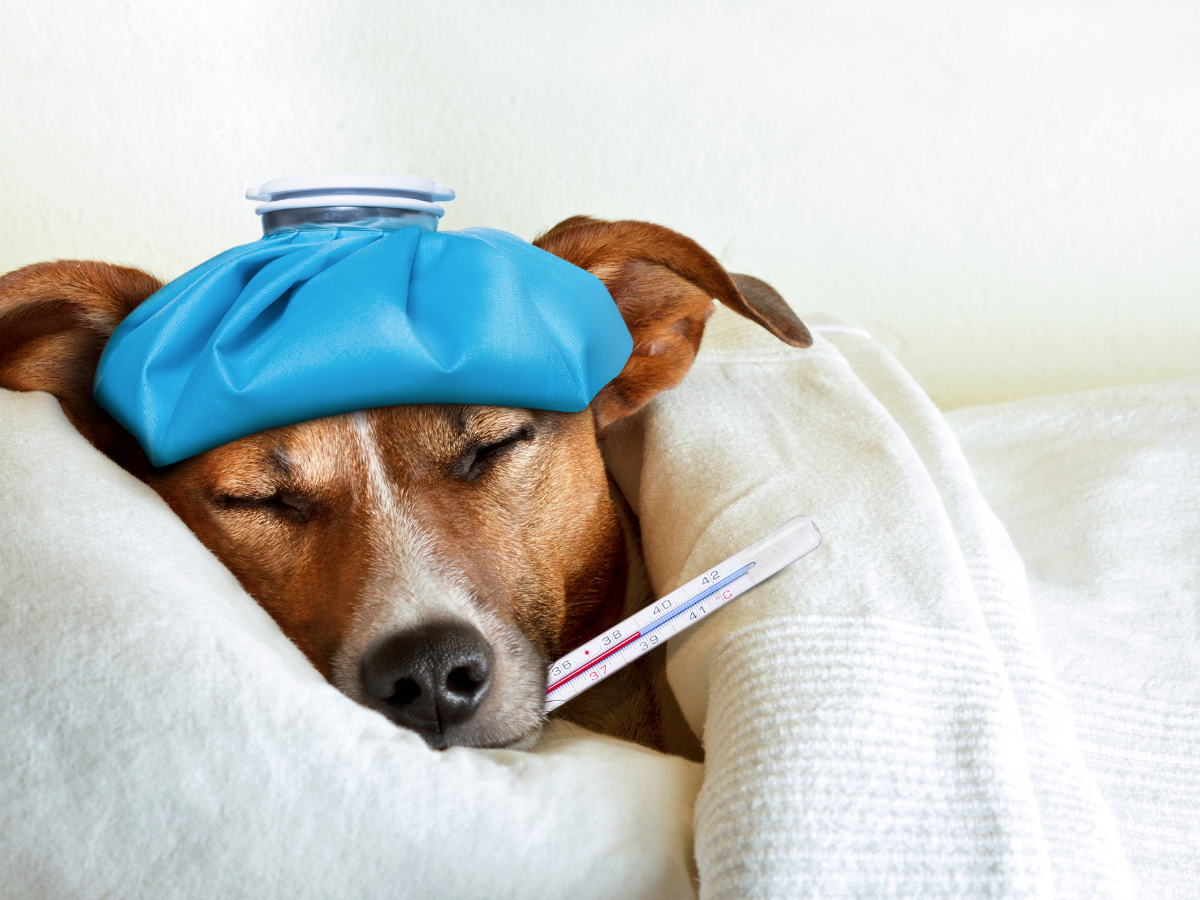Sick dog or cat with a fever? Use this safe anti-inflammatory

Being sick is NOT fun… and I and my daughter Aliza can personally attest to that 🙁
Night sweats… no energy… sore throat…
When your dog or cat has a fever, they are experiencing much the same thing we do.
Unfortunately there are very few safe options that we can give our pets to help lower a fever, except CBD (Cannabidiol).
And earlier animal research has hinted that fever triggered by a virus could be treated using CBD…
Dr. Jones’ Ultimate CBD for Dogs and Cats is a Full Spectrum CBD supplement in 100% Organic Cold Pressed Hemp Oil.
Here is Aliza and Tula in happier times without a fever 🙂

Fever in Dogs and Cats
SIGNS
Signs and symptoms of fever in dogs and cats include the primary one of having and above normal body temperature. Your pet may have a decreased appetite and lower energy. Your dog or cat’s ears can be hot to the touch and they may pant excessively in the house. Some pets will shiver, others can have an elevated heart rate. All much the same signs that people have with a fever.
CAUSES
A fever is usually caused by a bacterial or viral infection. Having a high temperature makes it more difficult for bugs to grow in the body. The problem with a fever in pets is that they will often stop drinking; dehydration then becomes the primary concern. A normal dog’s temperature is 101 degrees F (38 C); a normal cat’s temperature is 102 degrees F (38.5 C). Taking your pet’s temperature involves placing a thermometer in the rectum. If the temperature is103.5 F (39.5 C) or higher, your pet has a fever.
A fever is a response to something going on in your pet’s body. The most common cause, I find, is bite wounds. Search your dog or cat well for punctures.
SOLUTIONS
WHAT’S THE TEMP? Firstly start with the obvious, and take their temperature, determining if it is elevated. If the temperature is 103.5 F (39.5 C) or more, then they have a fever. If a fever persists for more than 24 hours, and your pet is not drinking, then call your veterinarian. If they are still drinking, or in the interim before going to your veterinarian, here are some additional remedies and supportive care that you can consider
1. KEEP HYDRATED – Offer plenty of fresh water in different spots around the house. If your pet refuses to drink, use an eyedropper or turkey baster to squirt water into the side of its mouth. Minerals become depleted when your pet is dehydrated; for an added boost, add Pedialyte, an electrolyte solution available from the pharmacy. Some pets prefer chicken or beef broth, or tuna juice; give them whatever works.
2. CALL YOUR VETERINARIAN – If a fever persists for more than twenty-four hours and your pet is not drinking, call your vet.
3. COOL COMPRESS – If your pet will tolerate it, apply a cold cloth to the belly. The exposed skin will result in some fairly rapid cooling, making your cat or dog feel a little better.
4. THE MEDICINE CABINET – Aspirin can be safely used in dogs to bring down a fever; NEVER use it in cats. The aspirin dose is one 325 mg tablet per forty pounds of body weight given every twelve hours.
HERBAL:
1. ECHINACEA, MYRRH, and SAGE – These are all excellent antimicrobial herbs. You can give a combined herbal formula of one drop per pound twice daily of the tincture. Another option is to use commercially prepared products such as Echinamide. The dose is 0.1 ml per ten pounds every eight hours.
2. ELDERBERRY and HONEY – This can be very effective for viral infections, as well as bacterial (the honey is a great anti-bacterial). I would suggest the concentrated elderberry powder, mixed with 1/2 teaspoon of honey/ 20lbs twice a day.
3. OLIVE LEAF EXTRACT – This can be an effective antibacterial , and antiviral treatment. Natural Anti-bacterial. An important olive leaf benefit is its ability to fight off infections, including candida infections, meningitis, pneumonia, chronic fatigue, hepatitis B, malaria, gonorrhea, shingles and tuberculosis. It also naturally treats ear, dental and urinary tract infections.
And a 2017 study found that olive leaf extract works as an antimicrobial agent that controls foodborne pathogens, including E. coli and salmonella.
Dog and Cat Doses. Dose range of 1mg-5 mg/lb twice daily
Start at the lower end, and up, assuming no vomiting/diarrhea
I would consider using this on my dog/cat with a skin, bladder infection, or even kennel cough.
When my wife and son were both sick coughing, they were taking my ‘NEW’ antiviral, anti cough concoction of…
- Elderberry concentrate (2000mg)
- Licorice Root tincture (2ml)
- Olive Leaf extract (500mg)
- 1 tablespoon of honey
HOMEOPATHIC:
1. FERRUM PHOS – For a dog or cat with fever, but no other serious recorded symptoms. The dose is 30C every four hours for two to three days.
2. HEPAR SULPH (hepar sulphuris calcareum) – Give one 30C tablet every six hours for three days.
3. ARNICA – Useful in fighting the aches and pains that go along with fever; give one 30C tablet per forty pounds of body weight every four to six hours.
4. CANNABIDIOL (CBD) – Research suggests that CBD may be used to treat fever caused by pathogens. CBD dose of 3mg/10lbs once to twice daily

Best Wishes,
Dr Andrew
P.S. Aliza is feeling better now, (thanks to the CBD!), and now seems especially happy to have her faithful companion Tula 🙂
P.P.S. It’s a great idea to have something on hand in case your dog/cat gets a fever- especially CBD as it comes with few to no side effects.
PLUS with cats this is the ONLY really safe and effective OTC treatment for Fever, as the can NEVER be given Aspirin, and I personally would be very cautious with giving any veterinary anti-inflammatory (i.e. Metacam).
Dr.Jones
It’s Marlene Jones, Long time follower
Thank you so much for all that you do
Advice,solutions,All the positive energy.Im catching up today on your videos. Primarily in search of a kidney flush for our 8 year old Labrador; She just underwent the CCL (TPLO PROCEDURE)
What a nightmare. I can only pray I made the right choice for her. She was 102pds when the injury occured, so I had no hope of her recovering on her own. Shes doing ok, we’re not out of the woods yet. Any advice would be appreciated. She had #2 fentanyl patches.When I removed the first 1, per surgeons orders, She crashed on me, could hardly hold her up, I called the MedVet ( Hosp here in F’D up Mi) Nurse replaced the patch. Again I removed it Dec 1. Still giving her 1/2 Trazadone at night, to help her rest and sleep, since surgeons orders were to keep her sedated 24/7, outdoors only to potty 5 min walks 3 to 4x daily.
What are your thoughts please